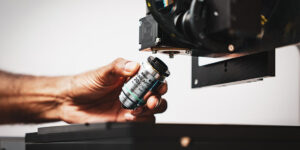Synopsis
Telepathology combines communication and technology to manage and share digital images remotely between pathologists and healthcare professionals. The workflow is helpful when the patient is in an underserved area or needs quick opinions from other pathologists and medical experts. In remote consultation, telepathology allows healthcare professionals to exchange accurate and reliable images and clinical information to make a quick and accurate diagnosis. Timely and quick diagnosis helps advance a patient’s treatment. Though there are cons to using telepathology and remote consultation, the challenges can be overcome with the ever-evolving technological advances and costs coming down.
Introduction
Telepathology and remote consultation are a part of digital pathology. Telepathology is the use of communication technology to manage and send digital images from one location to another for review by pathologists located in different locations. Laboratories benefit immensely from technological advances in telepathology. They can now operate from remote settings or underserved locations where there are not enough pathologists to serve locally. Telepathology can also be used in cases where a second opinion is needed or a pathologist with special expertise is required.
Key Types of Telepathology
The two types of telepathology are static and dynamic telepathology. The accuracy of static telepathology is 68% to 95% as compared to 95% to 100% of dynamic telepathology. To address the drawbacks of static and dynamic telepathology, hybrid telepathology is now used in many pathology set-ups.
Static Telepathology
In static telepathology, the images are transmitted electronically. Static telepathology systems are reasonably priced since they work with basic components such as a microscope, camera, and Internet. Furthermore, they are easy to use and require no special software to view the images. However, there is a drawback to these systems. They could be less effective if there are possible sampling field errors due to low-power magnification, lack of focus in still images, or inappropriate field selection by the submitting pathologist.
Dynamic Telepathology
Dynamic telepathology involves real-time transmission of images. A light microscope transmits the images to a remote place with robotic control of the stage for simultaneous diagnosis and consultation. A key benefit of the system is immediate access to off-site pathologists for rapid frozen section diagnoses and undermanned areas. The disadvantages of dynamic telepathology are its high cost and high maintenance. Additionally, a basic prerequisite for the system to operate is a stable and broad-bandwidth telecommunication link between the sender and the recipient.
Hybrid Systems
In hybrid systems, a series of static images are captured, automatically stitched together via software, and compressed to a single-file form. The images are transmitted simultaneously at the time of teleconsultation or tele-education. As a result, the time and cost of using robotic systems are reduced, and consultation time is hastened. Hybrid systems provide immediate consultations and improved patient care.
Use of Telepathology in Digital Pathology
Telepathology is a branch of telemedicine that uses telecommunication to electronically transmit digital pathology images. It is used for remote diagnosis, second opinions, quality assurance, education, and research purposes. The use of telepathology in clinical patient care has been largely limited to large academic institutions. The most common obstacles faced by researchers in the field of telepathology are high costs, legal and regulatory issues, technical shortcomings, pathologist resistance, and the lack of universal standards.
- One of the most common applications of digital telepathology is cancer diagnosis. By viewing high-resolution images of tissue, cancer cells can be identified more accurately and quickly than with a traditional microscope.
- Telepathology is also used to determine the diagnosis of diseases such as pneumonia, leukocytosis or bronchopneumonia. High-quality images of tissue samples can be viewed and microorganisms such as bacteria, viruses, and fungi can be identified.
- Digital telepathology is also used in the diagnosis of dermatologic conditions. It can display high-resolution images and make an accurate diagnosis. As with other diagnostic procedures, it is especially useful when there are not enough pathologists locally to cover a specific area.
- Pathologists also use digital telepathology to diagnose neurological or ophthalmic conditions. You can visualize high-resolution images of brain and eye samples, making it particularly useful for identifying various neurological and ophthalmic conditions such as glaucoma, Alzheimer’s disease, and multiple sclerosis more accurately and quickly than traditional microscope-based methods.
Quick Diagnosis
Telepathology is extremely useful when a quick and accurate diagnosis is needed, such as when a neurological or eye condition is suspected. It is also useful for diagnosis in rural or underdeveloped areas where there are not enough pathologists to provide diagnostic services locally.
Use of Remote Consultation in Digital Pathology
Since its early days, digital pathology has been used in telemedicine to share images and diagnose cases. However, with advances in technology and improvements in internet connectivity, the use of digital pathology has gained popularity in recent years. Healthcare professionals are beginning to realize the benefits of using digital pathology in telemedicine, which can enable faster diagnosis and treatment and improve patient outcomes.
Various Applications
Pathologists use digital pathology to provide remote diagnostic support for conditions such as cancer, infectious diseases, and dermatologic conditions. This enables faster diagnosis and treatment and improves patient outcomes. Simply put, digital pathology in telemedicine means sharing images, clinical information, and expertise between institutions. This can improve the quality of patient care, especially when a consultation with a specialist is required.
Conclusion
The clinical applications of telepathology are very diverse. Telepathology allows fast, efficient, and accurate diagnosis, especially in cancer, infectious diseases, dermatological, neurological, or ophthalmological diseases. Furthermore, it speeds up the entire diagnostic process and improves patient outcomes. The use of telepathology in teleconsultation enables a more efficient exchange of ideas and improved patient access to diagnostic services. The use of digital pathology in telepathology and teleconsultation is expected to continue to grow in the future to provide better services for patient care and treatment.











